Business Intelligence and Data Security: Fraud Detection and Methods
VerifiedAdded on 2020/04/01
|7
|1218
|54
Report
AI Summary
This report delves into the realm of Business Intelligence (BI) and its crucial aspects, including data security and fraud detection. It begins by defining BI and its role in enhancing decision-making, then explores the application of BI in identifying fraudulent transactions through advanced analytics and adherence to pre-set standards. The report highlights the significance of data security in BI, emphasizing the need for timely vulnerability assessments and risk prioritization. It identifies various security issues associated with BI, such as targeted cyberattacks, data breaches, reliance on cloud computing, and user adoption challenges. Furthermore, the report outlines essential security methods and strategies, including encryption, authentication, access control, physical and logical security measures, and tiered data protection. In conclusion, the report underscores the importance of BI in integrating business processes and facilitating effective decision-making, while also emphasizing the need for robust security measures to mitigate associated risks. The report provides a detailed overview of the security concerns within Business Intelligence, emphasizing methods for ensuring data protection and preventing fraud.
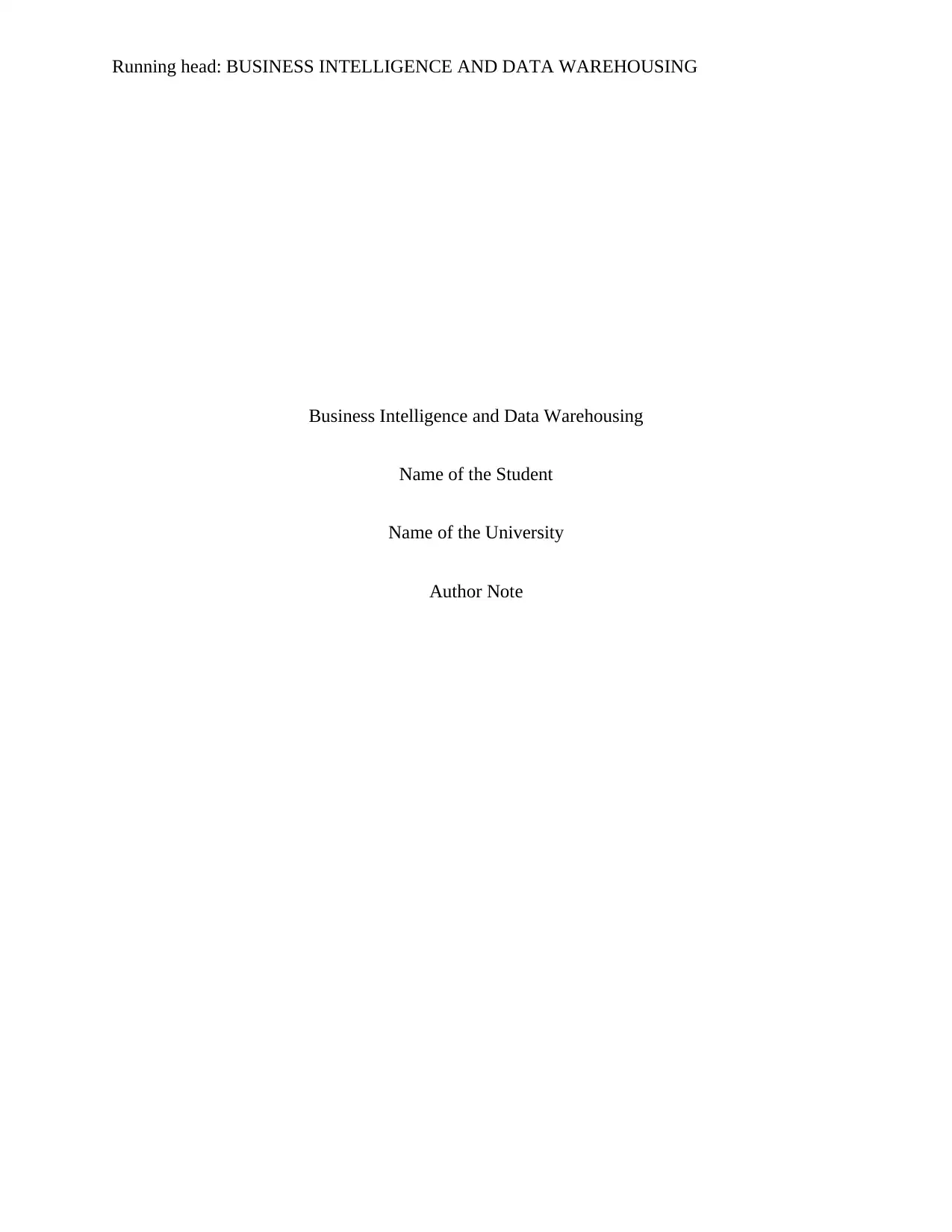
Running head: BUSINESS INTELLIGENCE AND DATA WAREHOUSING
Business Intelligence and Data Warehousing
Name of the Student
Name of the University
Author Note
Business Intelligence and Data Warehousing
Name of the Student
Name of the University
Author Note
Paraphrase This Document
Need a fresh take? Get an instant paraphrase of this document with our AI Paraphraser
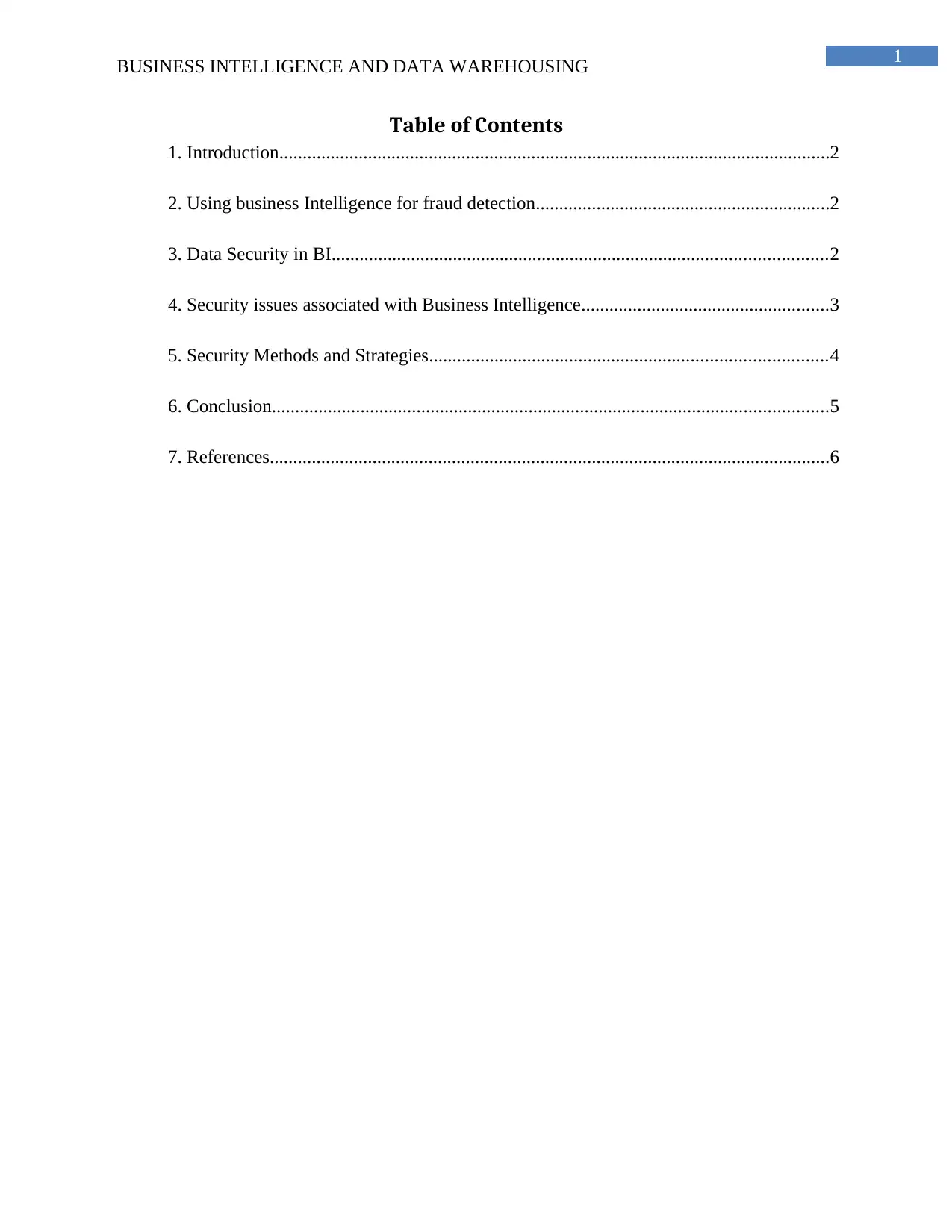
1
BUSINESS INTELLIGENCE AND DATA WAREHOUSING
Table of Contents
1. Introduction......................................................................................................................2
2. Using business Intelligence for fraud detection...............................................................2
3. Data Security in BI..........................................................................................................2
4. Security issues associated with Business Intelligence.....................................................3
5. Security Methods and Strategies.....................................................................................4
6. Conclusion.......................................................................................................................5
7. References........................................................................................................................6
BUSINESS INTELLIGENCE AND DATA WAREHOUSING
Table of Contents
1. Introduction......................................................................................................................2
2. Using business Intelligence for fraud detection...............................................................2
3. Data Security in BI..........................................................................................................2
4. Security issues associated with Business Intelligence.....................................................3
5. Security Methods and Strategies.....................................................................................4
6. Conclusion.......................................................................................................................5
7. References........................................................................................................................6
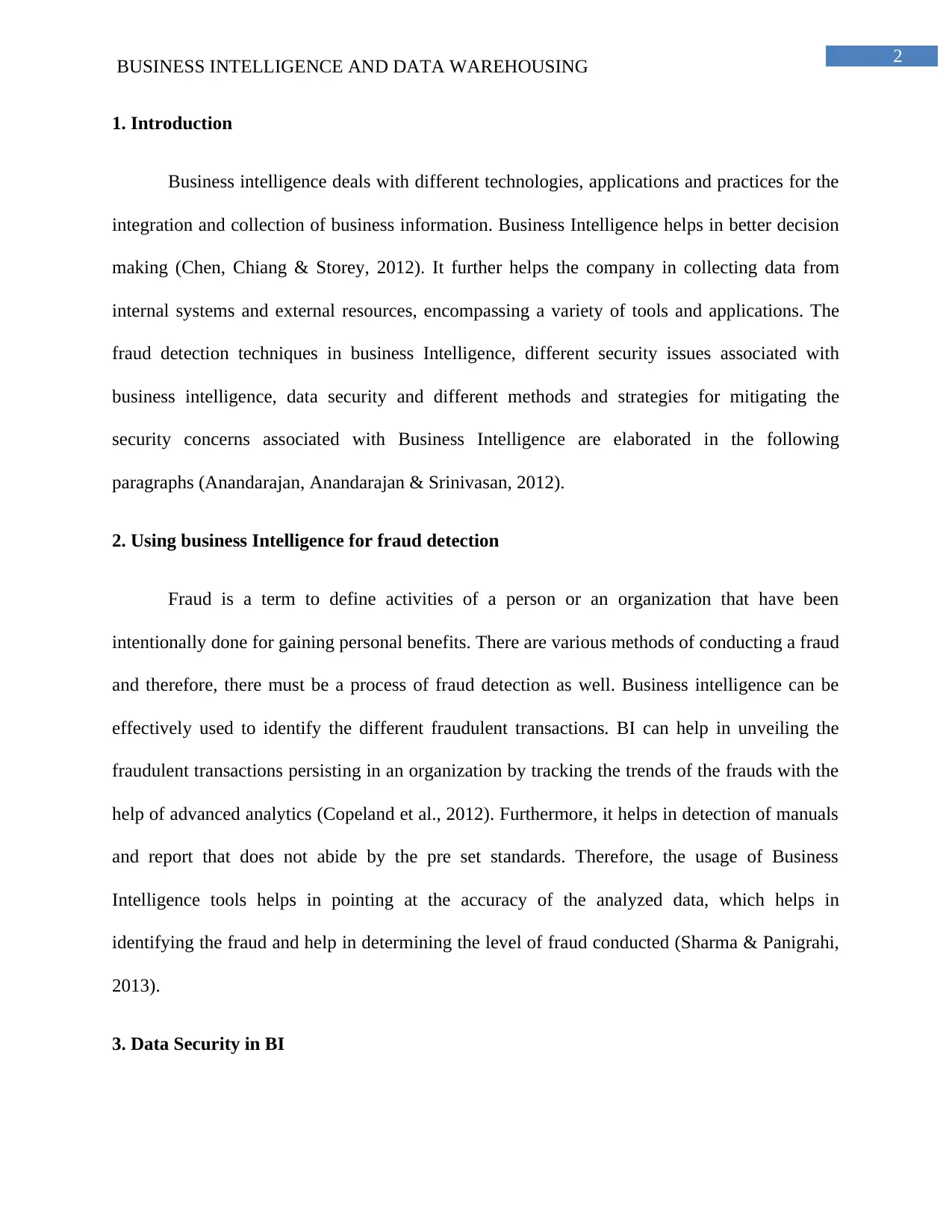
2
BUSINESS INTELLIGENCE AND DATA WAREHOUSING
1. Introduction
Business intelligence deals with different technologies, applications and practices for the
integration and collection of business information. Business Intelligence helps in better decision
making (Chen, Chiang & Storey, 2012). It further helps the company in collecting data from
internal systems and external resources, encompassing a variety of tools and applications. The
fraud detection techniques in business Intelligence, different security issues associated with
business intelligence, data security and different methods and strategies for mitigating the
security concerns associated with Business Intelligence are elaborated in the following
paragraphs (Anandarajan, Anandarajan & Srinivasan, 2012).
2. Using business Intelligence for fraud detection
Fraud is a term to define activities of a person or an organization that have been
intentionally done for gaining personal benefits. There are various methods of conducting a fraud
and therefore, there must be a process of fraud detection as well. Business intelligence can be
effectively used to identify the different fraudulent transactions. BI can help in unveiling the
fraudulent transactions persisting in an organization by tracking the trends of the frauds with the
help of advanced analytics (Copeland et al., 2012). Furthermore, it helps in detection of manuals
and report that does not abide by the pre set standards. Therefore, the usage of Business
Intelligence tools helps in pointing at the accuracy of the analyzed data, which helps in
identifying the fraud and help in determining the level of fraud conducted (Sharma & Panigrahi,
2013).
3. Data Security in BI
BUSINESS INTELLIGENCE AND DATA WAREHOUSING
1. Introduction
Business intelligence deals with different technologies, applications and practices for the
integration and collection of business information. Business Intelligence helps in better decision
making (Chen, Chiang & Storey, 2012). It further helps the company in collecting data from
internal systems and external resources, encompassing a variety of tools and applications. The
fraud detection techniques in business Intelligence, different security issues associated with
business intelligence, data security and different methods and strategies for mitigating the
security concerns associated with Business Intelligence are elaborated in the following
paragraphs (Anandarajan, Anandarajan & Srinivasan, 2012).
2. Using business Intelligence for fraud detection
Fraud is a term to define activities of a person or an organization that have been
intentionally done for gaining personal benefits. There are various methods of conducting a fraud
and therefore, there must be a process of fraud detection as well. Business intelligence can be
effectively used to identify the different fraudulent transactions. BI can help in unveiling the
fraudulent transactions persisting in an organization by tracking the trends of the frauds with the
help of advanced analytics (Copeland et al., 2012). Furthermore, it helps in detection of manuals
and report that does not abide by the pre set standards. Therefore, the usage of Business
Intelligence tools helps in pointing at the accuracy of the analyzed data, which helps in
identifying the fraud and help in determining the level of fraud conducted (Sharma & Panigrahi,
2013).
3. Data Security in BI
⊘ This is a preview!⊘
Do you want full access?
Subscribe today to unlock all pages.

Trusted by 1+ million students worldwide
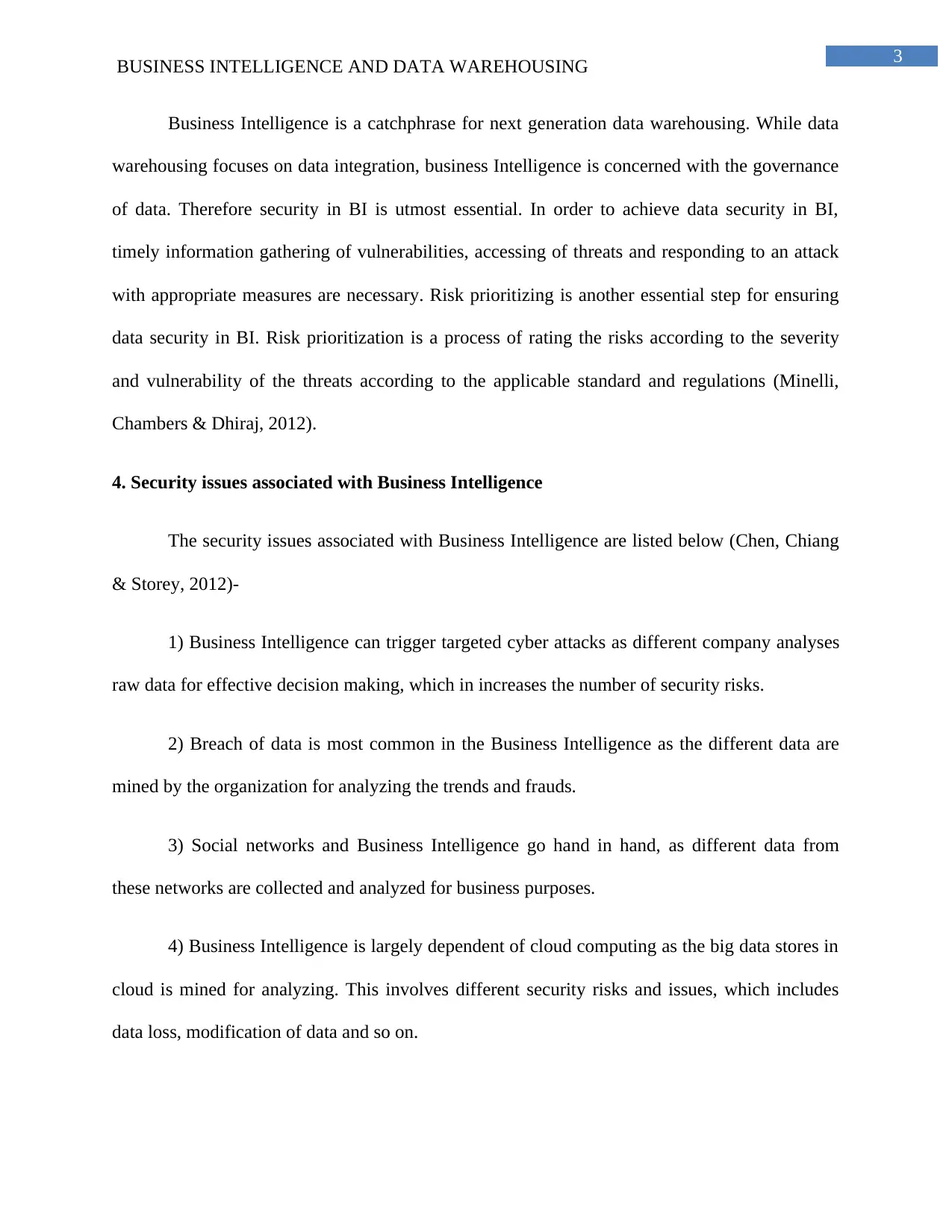
3
BUSINESS INTELLIGENCE AND DATA WAREHOUSING
Business Intelligence is a catchphrase for next generation data warehousing. While data
warehousing focuses on data integration, business Intelligence is concerned with the governance
of data. Therefore security in BI is utmost essential. In order to achieve data security in BI,
timely information gathering of vulnerabilities, accessing of threats and responding to an attack
with appropriate measures are necessary. Risk prioritizing is another essential step for ensuring
data security in BI. Risk prioritization is a process of rating the risks according to the severity
and vulnerability of the threats according to the applicable standard and regulations (Minelli,
Chambers & Dhiraj, 2012).
4. Security issues associated with Business Intelligence
The security issues associated with Business Intelligence are listed below (Chen, Chiang
& Storey, 2012)-
1) Business Intelligence can trigger targeted cyber attacks as different company analyses
raw data for effective decision making, which in increases the number of security risks.
2) Breach of data is most common in the Business Intelligence as the different data are
mined by the organization for analyzing the trends and frauds.
3) Social networks and Business Intelligence go hand in hand, as different data from
these networks are collected and analyzed for business purposes.
4) Business Intelligence is largely dependent of cloud computing as the big data stores in
cloud is mined for analyzing. This involves different security risks and issues, which includes
data loss, modification of data and so on.
BUSINESS INTELLIGENCE AND DATA WAREHOUSING
Business Intelligence is a catchphrase for next generation data warehousing. While data
warehousing focuses on data integration, business Intelligence is concerned with the governance
of data. Therefore security in BI is utmost essential. In order to achieve data security in BI,
timely information gathering of vulnerabilities, accessing of threats and responding to an attack
with appropriate measures are necessary. Risk prioritizing is another essential step for ensuring
data security in BI. Risk prioritization is a process of rating the risks according to the severity
and vulnerability of the threats according to the applicable standard and regulations (Minelli,
Chambers & Dhiraj, 2012).
4. Security issues associated with Business Intelligence
The security issues associated with Business Intelligence are listed below (Chen, Chiang
& Storey, 2012)-
1) Business Intelligence can trigger targeted cyber attacks as different company analyses
raw data for effective decision making, which in increases the number of security risks.
2) Breach of data is most common in the Business Intelligence as the different data are
mined by the organization for analyzing the trends and frauds.
3) Social networks and Business Intelligence go hand in hand, as different data from
these networks are collected and analyzed for business purposes.
4) Business Intelligence is largely dependent of cloud computing as the big data stores in
cloud is mined for analyzing. This involves different security risks and issues, which includes
data loss, modification of data and so on.
Paraphrase This Document
Need a fresh take? Get an instant paraphrase of this document with our AI Paraphraser
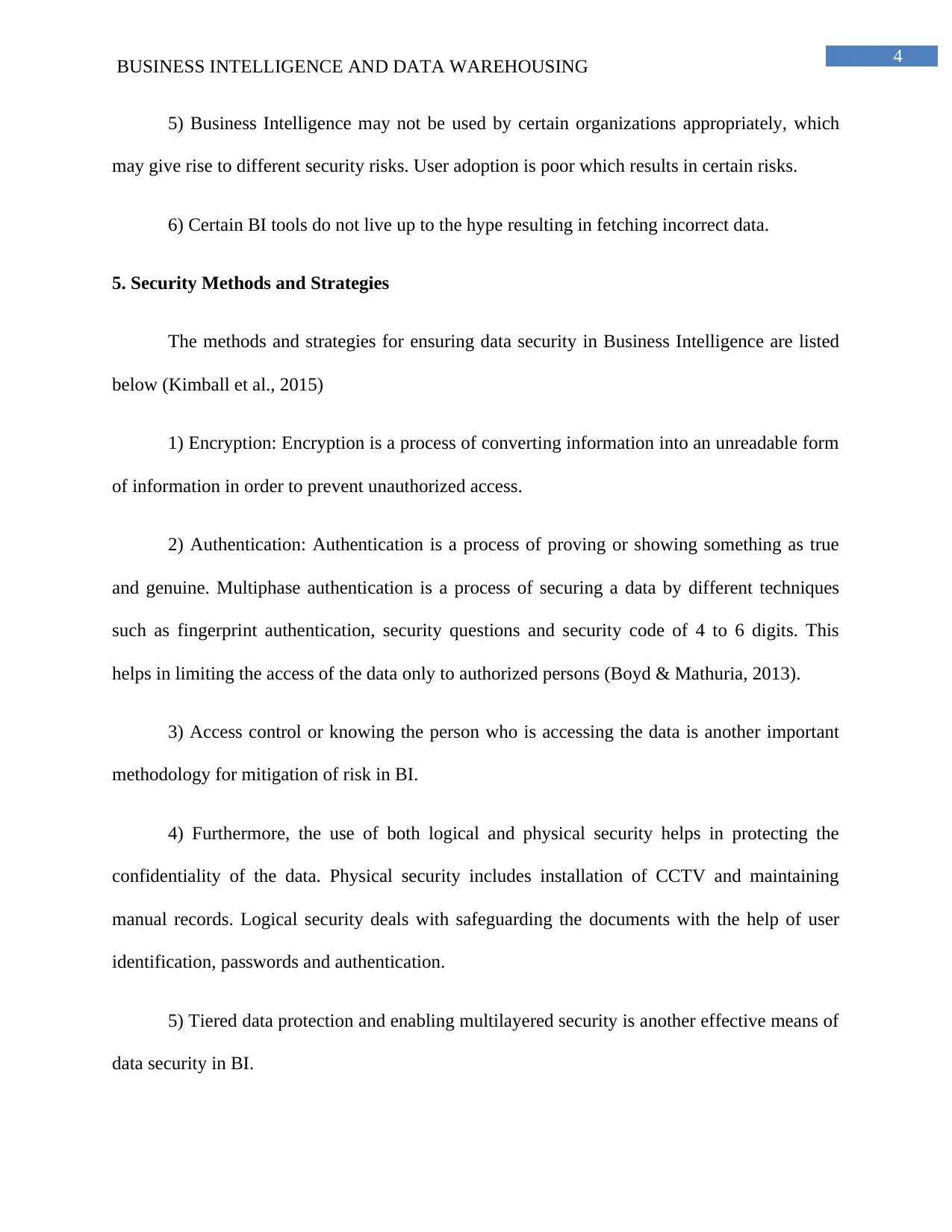
4
BUSINESS INTELLIGENCE AND DATA WAREHOUSING
5) Business Intelligence may not be used by certain organizations appropriately, which
may give rise to different security risks. User adoption is poor which results in certain risks.
6) Certain BI tools do not live up to the hype resulting in fetching incorrect data.
5. Security Methods and Strategies
The methods and strategies for ensuring data security in Business Intelligence are listed
below (Kimball et al., 2015)
1) Encryption: Encryption is a process of converting information into an unreadable form
of information in order to prevent unauthorized access.
2) Authentication: Authentication is a process of proving or showing something as true
and genuine. Multiphase authentication is a process of securing a data by different techniques
such as fingerprint authentication, security questions and security code of 4 to 6 digits. This
helps in limiting the access of the data only to authorized persons (Boyd & Mathuria, 2013).
3) Access control or knowing the person who is accessing the data is another important
methodology for mitigation of risk in BI.
4) Furthermore, the use of both logical and physical security helps in protecting the
confidentiality of the data. Physical security includes installation of CCTV and maintaining
manual records. Logical security deals with safeguarding the documents with the help of user
identification, passwords and authentication.
5) Tiered data protection and enabling multilayered security is another effective means of
data security in BI.
BUSINESS INTELLIGENCE AND DATA WAREHOUSING
5) Business Intelligence may not be used by certain organizations appropriately, which
may give rise to different security risks. User adoption is poor which results in certain risks.
6) Certain BI tools do not live up to the hype resulting in fetching incorrect data.
5. Security Methods and Strategies
The methods and strategies for ensuring data security in Business Intelligence are listed
below (Kimball et al., 2015)
1) Encryption: Encryption is a process of converting information into an unreadable form
of information in order to prevent unauthorized access.
2) Authentication: Authentication is a process of proving or showing something as true
and genuine. Multiphase authentication is a process of securing a data by different techniques
such as fingerprint authentication, security questions and security code of 4 to 6 digits. This
helps in limiting the access of the data only to authorized persons (Boyd & Mathuria, 2013).
3) Access control or knowing the person who is accessing the data is another important
methodology for mitigation of risk in BI.
4) Furthermore, the use of both logical and physical security helps in protecting the
confidentiality of the data. Physical security includes installation of CCTV and maintaining
manual records. Logical security deals with safeguarding the documents with the help of user
identification, passwords and authentication.
5) Tiered data protection and enabling multilayered security is another effective means of
data security in BI.
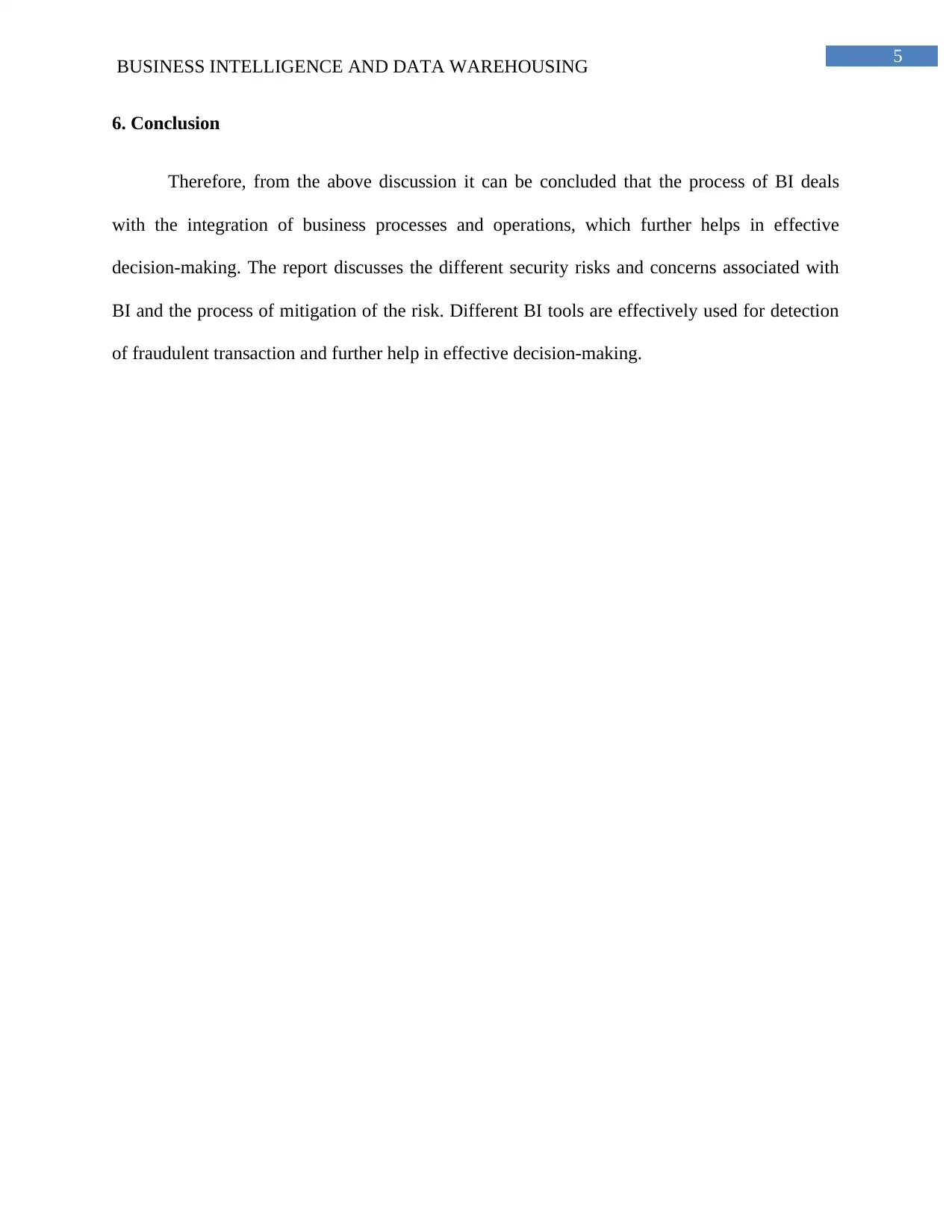
5
BUSINESS INTELLIGENCE AND DATA WAREHOUSING
6. Conclusion
Therefore, from the above discussion it can be concluded that the process of BI deals
with the integration of business processes and operations, which further helps in effective
decision-making. The report discusses the different security risks and concerns associated with
BI and the process of mitigation of the risk. Different BI tools are effectively used for detection
of fraudulent transaction and further help in effective decision-making.
BUSINESS INTELLIGENCE AND DATA WAREHOUSING
6. Conclusion
Therefore, from the above discussion it can be concluded that the process of BI deals
with the integration of business processes and operations, which further helps in effective
decision-making. The report discusses the different security risks and concerns associated with
BI and the process of mitigation of the risk. Different BI tools are effectively used for detection
of fraudulent transaction and further help in effective decision-making.
⊘ This is a preview!⊘
Do you want full access?
Subscribe today to unlock all pages.

Trusted by 1+ million students worldwide
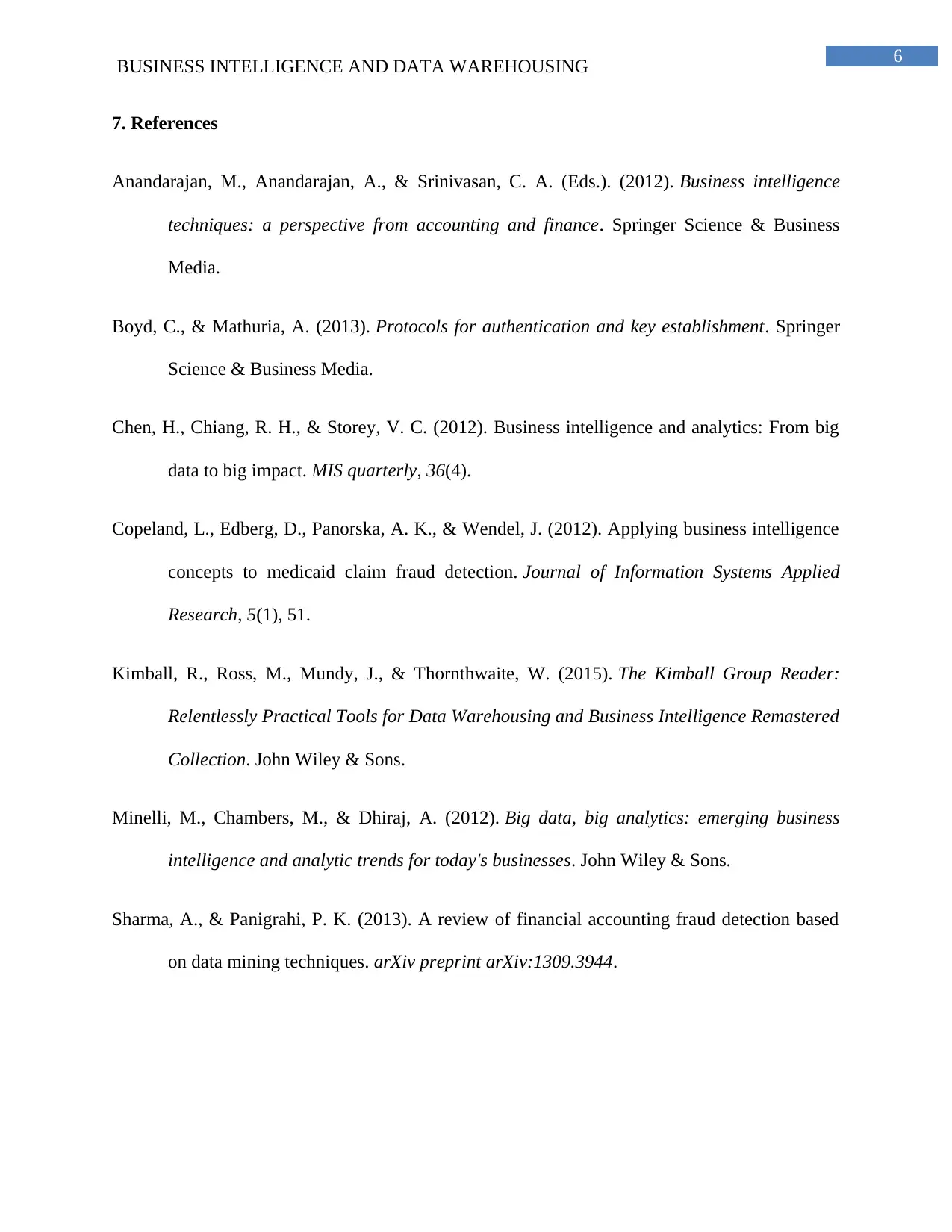
6
BUSINESS INTELLIGENCE AND DATA WAREHOUSING
7. References
Anandarajan, M., Anandarajan, A., & Srinivasan, C. A. (Eds.). (2012). Business intelligence
techniques: a perspective from accounting and finance. Springer Science & Business
Media.
Boyd, C., & Mathuria, A. (2013). Protocols for authentication and key establishment. Springer
Science & Business Media.
Chen, H., Chiang, R. H., & Storey, V. C. (2012). Business intelligence and analytics: From big
data to big impact. MIS quarterly, 36(4).
Copeland, L., Edberg, D., Panorska, A. K., & Wendel, J. (2012). Applying business intelligence
concepts to medicaid claim fraud detection. Journal of Information Systems Applied
Research, 5(1), 51.
Kimball, R., Ross, M., Mundy, J., & Thornthwaite, W. (2015). The Kimball Group Reader:
Relentlessly Practical Tools for Data Warehousing and Business Intelligence Remastered
Collection. John Wiley & Sons.
Minelli, M., Chambers, M., & Dhiraj, A. (2012). Big data, big analytics: emerging business
intelligence and analytic trends for today's businesses. John Wiley & Sons.
Sharma, A., & Panigrahi, P. K. (2013). A review of financial accounting fraud detection based
on data mining techniques. arXiv preprint arXiv:1309.3944.
BUSINESS INTELLIGENCE AND DATA WAREHOUSING
7. References
Anandarajan, M., Anandarajan, A., & Srinivasan, C. A. (Eds.). (2012). Business intelligence
techniques: a perspective from accounting and finance. Springer Science & Business
Media.
Boyd, C., & Mathuria, A. (2013). Protocols for authentication and key establishment. Springer
Science & Business Media.
Chen, H., Chiang, R. H., & Storey, V. C. (2012). Business intelligence and analytics: From big
data to big impact. MIS quarterly, 36(4).
Copeland, L., Edberg, D., Panorska, A. K., & Wendel, J. (2012). Applying business intelligence
concepts to medicaid claim fraud detection. Journal of Information Systems Applied
Research, 5(1), 51.
Kimball, R., Ross, M., Mundy, J., & Thornthwaite, W. (2015). The Kimball Group Reader:
Relentlessly Practical Tools for Data Warehousing and Business Intelligence Remastered
Collection. John Wiley & Sons.
Minelli, M., Chambers, M., & Dhiraj, A. (2012). Big data, big analytics: emerging business
intelligence and analytic trends for today's businesses. John Wiley & Sons.
Sharma, A., & Panigrahi, P. K. (2013). A review of financial accounting fraud detection based
on data mining techniques. arXiv preprint arXiv:1309.3944.
1 out of 7
Related Documents
Your All-in-One AI-Powered Toolkit for Academic Success.
+13062052269
info@desklib.com
Available 24*7 on WhatsApp / Email
![[object Object]](/_next/static/media/star-bottom.7253800d.svg)
Unlock your academic potential
Copyright © 2020–2025 A2Z Services. All Rights Reserved. Developed and managed by ZUCOL.




